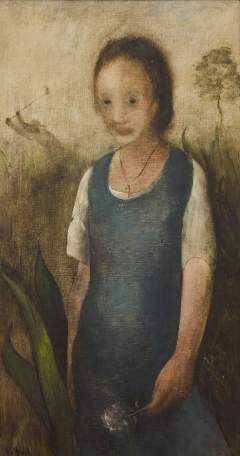Belle Of The Canefields
Sam Fullbrook

Details
- Artist
- Sam Fullbrook
- Title
- Belle Of The Canefields
- Medium
- oil on composition board
- Size
- 64.5 x 34 cm
- Details
signed lower left: Fullbrook
Sold This artwork has been sold. Please contact us for similar artworks.
Acquired by Private Collection.
Provenance
Unknown
Martin Browne Fine Art, Sydney
Collection of the late John Lockhart AO, QC, Sydney
Southebys, Important Australian Art, Sydney, 26 November 2007, lot 9
Private collection, Melbourne
Exhibited
Sam Fullbrook: Racing Colours, National Gallery of Victoria, Melbourne, 1995, cat.no. 2
Annual Collectors Exhibition 2008, Lauraine Diggins Fine Art, Melbourne, cat. no. 26
Literature
Moore, Felicity St John, Sam Fullbrook: Racing Colours, National Gallery of Victoria, Melbourne, p.17. illus
Annual Collector's Exhibition 2008, Malakoff Fine Art Press, Melbourne, 2008, p.31 (illus)
Further Information
Fullbrook's Belle of the Canefields is a rare and poetic gem from the artist's early Queensland period, when he travelled north in 1949-50 to work as a cane-cutter. According to Felicity St John Moore, the painting was completed upon the artist's return to Sydney. "The subject of this symbolic memory picture... was the daughter, tall and loose-limbed, of a Basque family with whom the artist worked as a cane-cutter in north Queensland. Her southern European beauty and the Crucifix around her neck seem to have sparked the idea of the Virgin Mary, as signified perhaps by her 'heavenly' blue dress and demure pose."
The painting intertwines major leitmotivs within Fullbrook's oeuvre. His penchant for seeking precedents in European art manifests itself in the parallels between Belle of the Canefields and Sir Joshua Reynolds's Miss Susannah Gale of c.1763-4 (by his own admission, the artist's favourite painting in the National Gallery of Victoria). The latter is echoed throughout, from the overall positioning of the figure, the elfin silhouette and the sloping shoulders, to the drawing of the hands and the repositioning of the symbolic flower. Miss Gale's aristocratic demeanour is replaced with the girl's more demure disposition, reflective of Gorky-inspired, social-realist tendencies within his paintings. As Moore pointed out, "Fullbrook's subjects are in the realist, educative mould [and] with the social comment tucked away... His figures are without pretence - universal types as well as individuals." The girl's indefinable racial mixture is indicative of the recurring theme of mixed breeding, or illegitimacy. The background figure of the cane-worker is at once remniscient of Millet's peasant figures and redolent of Marxist ideal of ennoblement by physical labour. The muted colour palette of the painting reflects "the beningn and romantic character of the regional landscape - alive with the colour of the minerals, inland rivers, vegetation, tropical fruit and farm crop with which it abounds."
Eugene Barilo von Reisberg
Quotes from Moore, Felicity St John, Sam Fullbrook: Racing Colours, National Gallery of Victoria, Melbourne, 1995, p.17
